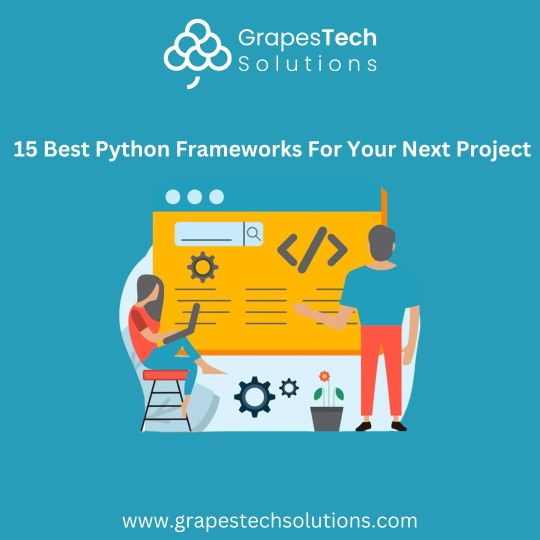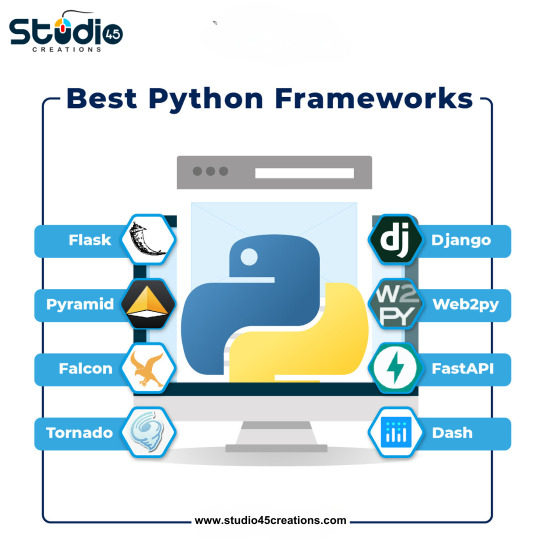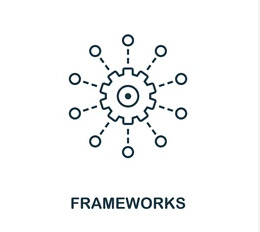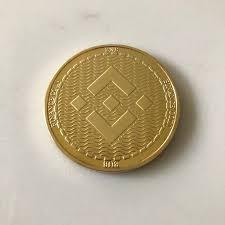#python framework
Explore tagged Tumblr posts
Text
Latest Django Development Companies in 2025

This blog represents the best Django Development Companies in 2025. This article starts with how Django develops robust and creative web applications. This article describes a better outline of the selection strategy. Online applications are strong and facilitate business achievement. Python framework enables developers to unlock the potential of Django Development. The guide provides details about selection criteria along with market trends and it includes a practical buyer’s checklist. Read More - https://www.linkedin.com/pulse/top-django-development-companies-2025-bhavika-patel-re8tf/
0 notes
Text
15 Best Python Frameworks For Website Development In 2024

The abundance of web application frameworks available for Python makes programming simpler, quicker, and more effective. A Python frameworks may be used for any kind of project, be it machine learning, data science, or web application development. The top 15 Python frameworks are listed here; look at them for your next project.
Read here: https://www.grapestechsolutions.com/blog/15-best-python-frameworks/
0 notes
Text
Top Python Frameworks for Game Development: Elevate Your Game Creation Skills
Summary: This blog explores top Python frameworks for game development. It compares Pygame, Pyglet, Kivy, Panda3D, and Ren'Py based on features, performance, and ideal use cases. Find out which framework suits your game project best.

Introduction
Python, renowned for its readability and versatility, has carved a niche in the realm of game development. Its simplicity and extensive libraries make it an attractive choice for both beginners and seasoned developers. This blog delves into the world of Python game development frameworks, providing insights into their strengths, weaknesses, and suitability for different projects.
Why Use Python for Game Development?
Python, with its elegant syntax and vast ecosystem, has emerged as a compelling choice for game development. Its readability and versatility make it accessible to a wide range of developers, from hobbyists to professionals. Beyond its reputation for simplicity and readability, Python offers several advantages for game development:
Rapid Prototyping
Python's interpreted nature accelerates the development cycle, allowing for swift experimentation and iteration. This is invaluable for testing game mechanics, refining gameplay, and visualizing concepts before committing to a full-fledged implementation.
Cross-Platform Compatibility
Many Python frameworks support multiple platforms, including desktop, mobile, and web. This expands the potential reach of your game, allowing you to target a wider audience.
Extensive Libraries and Tools
Python boasts a rich collection of libraries and tools that can be leveraged for game development. From graphics and sound to physics and artificial intelligence, you'll find the building blocks you need to create complex and engaging games.
Strong Community
The Python community is vast and active, providing a wealth of resources, tutorials, and support. You can find answers to your questions, share knowledge, and collaborate with other developers.
Criteria for Choosing a Python Game Development Framework
Selecting the right framework is crucial for a successful game development project. Key factors to consider include:
Game Genre: Different frameworks excel in specific genres. For example, 2D platformers might be better suited for Pygame, while complex 3D games could benefit from Panda3D.
Performance Requirements: If your game demands high-performance graphics or physics simulations, you'll need a framework capable of handling the load.
Platform Targeting: Ensure the framework supports the platforms you intend to release your game on (e.g., Windows, macOS, Linux, iOS, Android, web).
Ease of Use and Learning Curve: Consider the framework's learning curve and the availability of clear documentation and tutorials.
Community Support: A strong and active community can provide invaluable assistance, resources, and code examples.
Top Python Game Development Frameworks
Python offers a variety of powerful tools for game creation. This section highlights the most popular frameworks, comparing their strengths, weaknesses, and ideal use cases. Discover which framework aligns best with your game project and development goals.
Pygame
A simple and popular framework for creating 2D games. It offers a low-level interface to handle graphics, sound, and input, providing flexibility but requiring more coding.
Core Strengths: Simple to learn, cross-platform compatibility, extensive community support, suitable for 2D games.
Ideal Use Cases: Arcade games, puzzle games, platformers, and other 2D genres.
Limitations: Primarily focused on 2D graphics, performance might be a bottleneck for complex games.
Pyglet
Built on OpenGL, Pyglet is suitable for both 2D and 3D games. It offers better performance than Pygame and is often used for games with higher graphical demands.
Core Strengths: OpenGL integration, cross-platform support, suitable for both 2D and 3D games.
Ideal Use Cases: Games with demanding graphics, educational games, and prototyping.
Limitations: Steeper learning curve compared to Pygame, smaller community.
Kivy
A cross-platform framework focused on creating user interfaces for mobile and desktop applications. It's well-suited for games with interactive elements and touchscreens.
Core Strengths: Cross-platform compatibility, intuitive UI development, support for touch interfaces, suitable for mobile and desktop games.
Ideal Use Cases: Mobile games, interactive applications, and games with rich user interfaces.
Limitations: Performance might be a concern for highly demanding 3D games.
Panda3D
A powerful framework designed for creating complex 3D games. It offers advanced features like physics, rendering, and animation, but has a steeper learning curve.
Core Strengths: Real-time 3D rendering, physics engine, extensive toolset, large community, suitable for complex 3D games.
Ideal Use Cases: First-person shooters, role-playing games, simulations, and other 3D-intensive genres.
Limitations: Steeper learning curve, higher system requirements.
Ren'Py
Specifically designed for visual novels and interactive storytelling. It handles the core mechanics of these genres, making it easy to create branching narratives and character interactions.
Core Strengths: Specialized for visual novels, easy to use, supports branching storylines and character interactions.
Ideal Use Cases: Visual novels, interactive storytelling, and text-based adventures.
Limitations: Primarily focused on visual novels, limited for other game genres.
Comparative Analysis and Choosing the Right Framework
When selecting a framework, carefully evaluate your project's specific needs and constraints. Consider factors such as game genre, target platforms, performance requirements, and your team's experience.
For simple 2D games: Pygame is often the go-to choice due to its ease of use and large community.
For more complex 2D or simple 3D games: Pyglet offers better performance and OpenGL integration.
For cross-platform games with a focus on user interface: Kivy is a strong contender.
For ambitious 3D games: Panda3D provides the tools and power to create stunning visuals and complex gameplay.
For visual novels or interactive storytelling: Ren'Py is the specialized framework to consider.
Getting Started
Once you've chosen a framework, follow these steps to begin your game development journey:
Install the Framework: Download and install the framework according to the official documentation.
Learn the Basics: Familiarize yourself with the framework's core concepts, API, and workflow.
Create a Simple Game: Start with a small project to solidify your understanding.
Explore Features: Experiment with the framework's capabilities to discover its potential.
Leverage Community Resources: Take advantage of online forums, tutorials, and code examples.
By carefully considering your project's requirements and leveraging the strengths of each framework, you can create exceptional games with Python.
Conclusion
Python offers a rich ecosystem of frameworks for game development, catering to various project requirements and skill levels. By carefully considering your project's needs and exploring the strengths and weaknesses of each framework, you can select the ideal tool to bring your game ideas to life.
Remember, the best framework is the one that empowers you to create engaging and enjoyable gaming experiences.
Frequently Asked Questions
Which Python Framework Is Best for Beginners In Game Development?
Pygame is generally recommended for beginners due to its simplicity, large community, and extensive documentation. It's ideal for starting with 2D game development.
Can I Create 3D Games with Python?
Yes, Python offers frameworks for 3D game development. Panda3D is a popular choice for creating complex 3D games with realistic graphics and physics.
What are the Key Factors to Consider When Choosing a Python Game Framework?
Consider your game's genre (2D or 3D), desired platform, performance needs, and your team's experience. Also, evaluate the framework's learning curve, community support, and available resources.
#Top Python Frameworks for Game Development#Game Development#python#python framework#games#video games#python frameworks
0 notes
Text

Python Frameworks
Studio45Creations presents a powerful Python framework, seamlessly blending functionality and simplicity. Elevate your development experience with our innovative framework, designed for efficiency and ease of use. Unleash the full potential of Python with Studio45Creations.
0 notes
Text
Mobile app development adoption is growing at a rapid speed. To create a perfect mobile app one should thoroughly analyze the requirements, budget, and technology on which they wanted to create their software. Python has emerged as a most versatile programming language when it comes to developing cross-platform mobile applications. Its ability to run effortlessly on all platforms, easy-to-read syntax, support of various development frameworks, and wider community support make it the preferred choice of developers to create versatile applications.
if you’re scrutinizing for an efficient and robust Python App Development Company for your next cross-platform app development project choose CDN Solutions Group blindly and harness the full potential of Python programming language with us.
#python app development#mobile app development company#android app solutions#Python development services#python framework#Hire App Developer
0 notes
Text










The attention to men's fashion in the iconic museum is not from today. In 2003, "Men in Skirts" became the first exhibition entirely focused on the man's wardrobe, but the theme of the time comes with a twist. After the Black Lives Matter movement in 2020, the Costume Institute acquired about 150 pieces of clothing created by non-white designers, some of which will be exhibited in the new exhibition.
Following the historical tradition of the museum, items from the 18th and 19th centuries will also be present, alongside suits from the 1940s and recent designs created by Pharrell Williams and Virgil Abloh at Louis Vuitton.
The main focus of the exhibition will revolve around the discussion of the essence of black dandism: more than the construction of an identity, it is a concept that has crossed enslaved and culturally segregated generations. In all, there will be 12 sections in the museum dedicated to each of the characteristics of black dandism described in Zora Neale Hurston's 1934 essay, "The Characteristics of Negro Expression". In addition to clothes and accessories, paintings, photographs and excerpts from films will also be part of the show.
#pharrell williams#playstation7#ps7#python#digitalconsole#framework#celestiallink#deardearestbrands#soundcloud#digimonsoundtrack#digimon game#louis vuitton#luv#mousequteers#Nike LouisVuitton#DigimonWorld#virgil abloh#DearDearestBrands VirgilAbloh
12 notes
·
View notes
Text
"learn to code" as advice is such bullshit. i have learned and used four and a half different coding languages through my career (html/css, java, python+sql, c++) and when i say used i mean I've built things in every one but the things that i actually used these languages for??? these earn zero money (with the caveat of until you have seniority in, e.g. front end web dev) what people really mean when they say learn coding is "learn to code. go into investment banking or finance startups." coding does not inherently have money in it. my absolute favourite part of coding? my peak enjoyment? was when i was developing for a visual coding language (you put it together like a flowchart, so say youre using a temperature sensor and you want it to log the temperature once every four hours, you can put the blocks together to make it do that. i was writing the code behind the blocks for new sensors) and i was earning £24k a year and that wasn't even part of my main role. it was an extra voluntary thing i was doing (i was working as a research assistant in biosensors - sort of - at a university, and was developing the visual code for students who didnt want to learn c++) like. i want people to learn to code, i want people to know how their electrical equipment works and how coding works, but dont believe the myth that there is inherently money in coding. the valuable things, the things people are passionate about are still vulnerable to the passion tax (if you want to do it you dont have to be paid for it). skills arent where the money is, money is where the money is.
#this is a bit incoherent but you know what i mean#i hated coding because it made my brain bend into shapes i didn't like but i did a Lot of coding and i was quite good at it#c++ for mechatronics (coding for mechanical devices usually things id built myself lol x) was my sweet spot#.jtxt#the half language is sql#you could count html and css as different languages. but css is like a framework for html so i dont jfbdhd. maybe thats another half#ive learned and used five languages where css and sql are both half languages jfbshs#also before anyone is like but you can use python for backend web dev and everyone needs that or blah blah databases#i knoooooow. create an extra 20000 database experts and you'll make that a minimum wage role. love it#anyway i used python for my research all the way through my research. from like machine code to image analysis software thatd take half a#day to run bc of the ridiculous volume of my image folders
11 notes
·
View notes
Text
Desentrañando los Frameworks: La Poderosa Infraestructura que Impulsa el Desarrollo de Software

Un Framework es un conjunto de herramientas, bibliotecas y convenciones que proporciona una estructura básica para el desarrollo y la implementación de software. Es un esqueleto predefinido que facilita la creación y organización de aplicaciones al proporcionar bloques de construcción reutilizables.
En el desarrollo de software, un framework proporciona una infraestructura genérica que los desarrolladores pueden personalizar para crear aplicaciones específicas. Esto ayuda a acelerar el proceso de desarrollo, ya que los desarrolladores no tienen que comenzar desde cero, sino que pueden aprovechar las funcionalidades y abstracciones preexistentes.
Los frameworks son comunes en diversos campos del desarrollo de software, como desarrollo web, desarrollo de aplicaciones móviles, desarrollo de juegos, etc. Algunos ejemplos de frameworks populares son Django y Flask para desarrollo web con Python, Ruby on Rails para Ruby, Angular y React para JavaScript, y Laravel para PHP.
En resumen, un Framework es una estructura predefinida que simplifica y agiliza el desarrollo de software al proporcionar un conjunto de herramientas y convenciones comunes.
3 notes
·
View notes
Text
Я парочку дней решил пообщаться с джином, и мы с ним вещей наделали.
Что я еще собираюсь сделать? Ну есстественно это постоянно улучшать по возможности как функционал, так и интерфейс.
Хочу добавить статистики интерактивной, с парсерами, с постоянным мониторингом, во время работы процесса сервера... Что бы статистику делать реалтайм... На главной странице сделать один блок, который будет как бы постоянным, т.е. закреплённым. А котором будет так же какая нибудь интерактивная информация. Поиск верну)...
0 notes
Text
Does learning Java increase my salary?
1. Introduction to the Java Job Market
Java is still one of the hottest programming languages out there. Whether you're just starting or have been coding for a while, knowing Java can really help your career. A common question is: Does learning Java boost my paycheck? The answer is yes—companies really want people who know Java because it's so flexible for web, mobile, and big business apps. Key topics include Java programming, Java developers, and job roles related to it.
Key Point: Java skills are in demand across different industries and can help increase your salary.
2. Java's Popularity and Market Demand
Big names like Amazon, Netflix, and Google use Java because it handles large-scale apps well. So, does learning Java increase my salary? Definitely. Employers will pay a premium for those who are good at Java. Key terms include Java software development, full stack, and backend developer.
Key Point: There’s a strong demand for Java devs, which leads to better pay and job security.
3. Java Skills and Salary Growth
Having Java skills gives you an edge. Companies are looking for people who know frameworks like Spring Boot and tools like Maven. Will learning Java increase my salary? For sure. With the right certifications and experience, you can earn more. And signing up for a Java course in Coimbatore can really help solidify your skills.
Key Point: Specialized Java knowledge can lead to promotions and salary increases.
4. Role of Certifications in Salary Hike
Getting a Java certification is a smart way to stand out. A lot of people choose the Java Full Stack Developer Course in Coimbatore for hands-on practice. Certifications prove your skills, and the answer to the question: Does learning Java bump up my salary? Yes.
Key Point: Java certifications help validate your skills and can lead to better pay.
5. Java Job Roles and Their Pay Scales
Java jobs range from junior developers to senior architects, and each level comes with higher pay. A Java training in Coimbatore can get you ready for roles like Full Stack Developer or Software Engineer. Is there a salary increase if you learn Java? Absolutely, especially for specialized roles.
Key Point: There are many roles in Java, and each offers attractive salary packages.
6. Java vs. Other Programming Languages in Salary
Java developers often earn more than those working with less popular languages. Unlike some newer languages, Java jobs tend to be more stable. Does learning Java mean better pay? Yes, compared to other languages, Java usually offers more consistent salaries.
Key Point: Java's long-standing presence in the industry generally means better pay than many newer languages.
7. Full Stack Java Developer Salary Benefits
Full Stack Java Developers are among the best paid in tech. Taking a Java Full Stack Developer Course in Coimbatore can prepare you for the job market. Will learning Java increase my salary? For sure—especially in full stack roles where you need to be skilled in both backend and frontend.
Key Point: Full Stack Java positions offer top salaries and are in high demand.
8. Java's Role in Enterprise Applications
Java is key for many enterprise systems. Learning enterprise-level Java can really answer the question: Does it help me earn more? Yes. A training program in Coimbatore that teaches things like Hibernate and JSP is worth considering.
Key Point: Skills in enterprise Java can set you up for well-paying jobs.
9. Local Training Institutes and Career Impact
Joining a local Java course in Coimbatore can boost your earnings. These programs offer hands-on projects and guidance from experts. So, does learning Java help with salary? Yes—local training can lead to quicker job growth.
Key Point: Local Java training can speed up your skills and help with job placements.
10. Final Thoughts and Brand Mention
In summary, does learning Java increase my salary? Yes, through certifications, full stack skills, and local training. Consider a reputable place like Xplore It Corp for training in Coimbatore, offering courses designed to meet job market needs.
Key Point: Xplore It Corp provides practical Java courses that can help you earn more.
FAQs:
1. Does learning Java help me earn more with no experience?
Yes. Even beginners can get better job offers after certified Java training.
2. What’s the average salary after a Java course in Coimbatore?
Freshers typically earn around ₹3-5 LPA, and pay can increase significantly after 1-2 years.
3. Is a Java Full Stack Developer Course in Coimbatore worth it?
Definitely. Full stack developers are in demand and usually earn 20-30% more.
4. How long before I see salary benefits after Java training?
Usually, you can expect to see salary increases within 6-12 months after completing the course.
5. Can I switch to Java and expect a pay increase?
Yes. Many people move from non-tech jobs to Java and see a boost in their salary.
#Java programming#Java developer#Java applications#Core Java#Java certification#Java frameworks#Spring Framework#Java full stack#Java backend developer#Java software development#Java training course#Java job roles#Object-oriented programming#Java IDE#Java runtime environment#Java REST API#J2EE#Java vs Python#Java vs JavaScript#Secure Java coding#Java deployment#Java enterprise solutions#Java bootcamp#Java multithreading#Java performance optimization
0 notes
Text
Decode DSA with Python: Comprehensive Learning Including Python Tuple
Master Data Structures and Algorithms (DSA) with Python in this comprehensive guide. Learn key concepts step-by-step, including how Python tuples play a role in efficient coding. Whether you're preparing for coding interviews or improving your problem-solving skills, this tutorial offers practical insights and clear examples to boost your understanding of Python-based DSA. Click to read the complete guide
#bca course subjects#python tuple#Exception handling in Java#Collection framework in java#Inheritance in java#Interface in Java
0 notes
Text
What is Data Structure in Python?
Summary: Explore what data structure in Python is, including built-in types like lists, tuples, dictionaries, and sets, as well as advanced structures such as queues and trees. Understanding these can optimize performance and data handling.

Introduction
Data structures are fundamental in programming, organizing and managing data efficiently for optimal performance. Understanding "What is data structure in Python" is crucial for developers to write effective and efficient code. Python, a versatile language, offers a range of built-in and advanced data structures that cater to various needs.
This blog aims to explore the different data structures available in Python, their uses, and how to choose the right one for your tasks. By delving into Python’s data structures, you'll enhance your ability to handle data and solve complex problems effectively.
What are Data Structures?
Data structures are organizational frameworks that enable programmers to store, manage, and retrieve data efficiently. They define the way data is arranged in memory and dictate the operations that can be performed on that data. In essence, data structures are the building blocks of programming that allow you to handle data systematically.
Importance and Role in Organizing Data
Data structures play a critical role in organizing and managing data. By selecting the appropriate data structure, you can optimize performance and efficiency in your applications. For example, using lists allows for dynamic sizing and easy element access, while dictionaries offer quick lookups with key-value pairs.
Data structures also influence the complexity of algorithms, affecting the speed and resource consumption of data processing tasks.
In programming, choosing the right data structure is crucial for solving problems effectively. It directly impacts the efficiency of algorithms, the speed of data retrieval, and the overall performance of your code. Understanding various data structures and their applications helps in writing optimized and scalable programs, making data handling more efficient and effective.
Read: Importance of Python Programming: Real-Time Applications.
Types of Data Structures in Python
Python offers a range of built-in data structures that provide powerful tools for managing and organizing data. These structures are integral to Python programming, each serving unique purposes and offering various functionalities.
Lists
Lists in Python are versatile, ordered collections that can hold items of any data type. Defined using square brackets [], lists support various operations. You can easily add items using the append() method, remove items with remove(), and extract slices with slicing syntax (e.g., list[1:3]). Lists are mutable, allowing changes to their contents after creation.
Tuples
Tuples are similar to lists but immutable. Defined using parentheses (), tuples cannot be altered once created. This immutability makes tuples ideal for storing fixed collections of items, such as coordinates or function arguments. Tuples are often used when data integrity is crucial, and their immutability helps in maintaining consistent data throughout a program.
Dictionaries
Dictionaries store data in key-value pairs, where each key is unique. Defined with curly braces {}, dictionaries provide quick access to values based on their keys. Common operations include retrieving values with the get() method and updating entries using the update() method. Dictionaries are ideal for scenarios requiring fast lookups and efficient data retrieval.
Sets
Sets are unordered collections of unique elements, defined using curly braces {} or the set() function. Sets automatically handle duplicate entries by removing them, which ensures that each element is unique. Key operations include union (combining sets) and intersection (finding common elements). Sets are particularly useful for membership testing and eliminating duplicates from collections.
Each of these data structures has distinct characteristics and use cases, enabling Python developers to select the most appropriate structure based on their needs.
Explore: Pattern Programming in Python: A Beginner’s Guide.
Advanced Data Structures

In advanced programming, choosing the right data structure can significantly impact the performance and efficiency of an application. This section explores some essential advanced data structures in Python, their definitions, use cases, and implementations.
Queues
A queue is a linear data structure that follows the First In, First Out (FIFO) principle. Elements are added at one end (the rear) and removed from the other end (the front).
This makes queues ideal for scenarios where you need to manage tasks in the order they arrive, such as task scheduling or handling requests in a server. In Python, you can implement a queue using collections.deque, which provides an efficient way to append and pop elements from both ends.
Stacks
Stacks operate on the Last In, First Out (LIFO) principle. This means the last element added is the first one to be removed. Stacks are useful for managing function calls, undo mechanisms in applications, and parsing expressions.
In Python, you can implement a stack using a list, with append() and pop() methods to handle elements. Alternatively, collections.deque can also be used for stack operations, offering efficient append and pop operations.
Linked Lists
A linked list is a data structure consisting of nodes, where each node contains a value and a reference (or link) to the next node in the sequence. Linked lists allow for efficient insertions and deletions compared to arrays.
A singly linked list has nodes with a single reference to the next node. Basic operations include traversing the list, inserting new nodes, and deleting existing ones. While Python does not have a built-in linked list implementation, you can create one using custom classes.
Trees
Trees are hierarchical data structures with a root node and child nodes forming a parent-child relationship. They are useful for representing hierarchical data, such as file systems or organizational structures.
Common types include binary trees, where each node has up to two children, and binary search trees, where nodes are arranged in a way that facilitates fast lookups, insertions, and deletions.
Graphs
Graphs consist of nodes (or vertices) connected by edges. They are used to represent relationships between entities, such as social networks or transportation systems. Graphs can be represented using an adjacency matrix or an adjacency list.
The adjacency matrix is a 2D array where each cell indicates the presence or absence of an edge, while the adjacency list maintains a list of edges for each node.
See: Types of Programming Paradigms in Python You Should Know.
Choosing the Right Data Structure
Selecting the appropriate data structure is crucial for optimizing performance and ensuring efficient data management. Each data structure has its strengths and is suited to different scenarios. Here’s how to make the right choice:
Factors to Consider
When choosing a data structure, consider performance, complexity, and specific use cases. Performance involves understanding time and space complexity, which impacts how quickly data can be accessed or modified. For example, lists and tuples offer quick access but differ in mutability.
Tuples are immutable and thus faster for read-only operations, while lists allow for dynamic changes.
Use Cases for Data Structures:
Lists are versatile and ideal for ordered collections of items where frequent updates are needed.
Tuples are perfect for fixed collections of items, providing an immutable structure for data that doesn’t change.
Dictionaries excel in scenarios requiring quick lookups and key-value pairs, making them ideal for managing and retrieving data efficiently.
Sets are used when you need to ensure uniqueness and perform operations like intersections and unions efficiently.
Queues and stacks are used for scenarios needing FIFO (First In, First Out) and LIFO (Last In, First Out) operations, respectively.
Choosing the right data structure based on these factors helps streamline operations and enhance program efficiency.
Check: R Programming vs. Python: A Comparison for Data Science.
Frequently Asked Questions
What is a data structure in Python?
A data structure in Python is an organizational framework that defines how data is stored, managed, and accessed. Python offers built-in structures like lists, tuples, dictionaries, and sets, each serving different purposes and optimizing performance for various tasks.
Why are data structures important in Python?
Data structures are crucial in Python as they impact how efficiently data is managed and accessed. Choosing the right structure, such as lists for dynamic data or dictionaries for fast lookups, directly affects the performance and efficiency of your code.
What are advanced data structures in Python?
Advanced data structures in Python include queues, stacks, linked lists, trees, and graphs. These structures handle complex data management tasks and improve performance for specific operations, such as managing tasks or representing hierarchical relationships.
Conclusion
Understanding "What is data structure in Python" is essential for effective programming. By mastering Python's data structures, from basic lists and dictionaries to advanced queues and trees, developers can optimize data management, enhance performance, and solve complex problems efficiently.
Selecting the appropriate data structure based on your needs will lead to more efficient and scalable code.
#What is Data Structure in Python?#Data Structure in Python#data structures#data structure in python#python#python frameworks#python programming#data science
6 notes
·
View notes
Text

Know what Python Code is and how well you can deduce Python frameworks with quick steps. Deploy seamless unit testing as a top data scientist with sheer skills!
0 notes
Text
BINANCE X DEARDEARESTBRANDS
[The Proposal]






The document provides an intriguing development between Binance and #DearDearestBrands, with key highlights being:
Binance and TheeForestKingdom Collaboration: Binance's CEO has made significant strides toward a formal alliance with TheeForestKingdom, even exploring a potential marriage proposal to Bambi Prescott, regarded as the Royal Princess and Heir of TheeForestKingdom.
Agreement with Chinese Authorities: Talks with Chinese officials have apparently led to China allowing Binance to establish headquarters within its borders—a historic move, given previous restrictions on crypto companies.
Involvement of Notable Figures: Influential figures like Michael Eisner and Bill Gates are invited to Beijing for discussions. Additionally, DearDearestBrands' rising star 'Chanel' and related idols received a direct invitation from China's government, emphasizing a personal touch in fostering diplomatic and business ties.
Is there a specific angle or further analysis you’d like on this collaboration?
#BINANCE X DEARDEARESTBRANDS#BINANCE#deardearestbrands#playstation7#ps7#digitalconsole#framework#python#crypto#blockchain#investment#CEO BINANCE#CHINA BINANCE
17 notes
·
View notes
Text
Flask Development Company in Australia
LDS Engineers is a leading Flask development company in Australia offering top-notch web development services across Australia, the UK, the USA, and India. With years of experience and a team of skilled professionals, we specialize in creating reliable, scalable, and cost-effective Flask applications tailored to meet your unique business needs. Whether it’s a small web-based solution or a complex…

View On WordPress
#flask application development#flask application development services#flask application framework services#flask development#flask development services#flask framework development#flask programming services.#flask software development#flask web application framework services#flask web development#python flask development
0 notes
Text
Master Web Development with Django: Python Framework for Beginners to Pros
Take your web development skills to the next level with this comprehensive course on Django, the powerful Python framework designed to simplify building modern, feature-rich web applications. Whether you're just starting or looking to advance your existing knowledge, this course equips you with the tools and techniques needed to create robust, scalable, and dynamic websites
0 notes